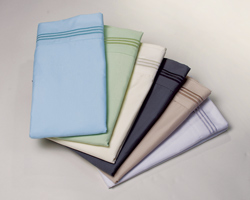 Expanding your retail merchandise always comes with the same set of questions: what do I want to sell next and how do I begin selling those items? In order to assist our readers in reaching their highest selling potential, Independent Retailer created a monthly series called “Beyond Your Lines.” Here we provide you with the best tips from experts in their selling categories on how to grow your business, what to expect from the merchandiser and what they will require from you, to ensure an effective and efficient exchange. Continuing our segment will be Simar Sethi, Vice President of Business Relations at Duke Imports (www.dukeimports.com), who will shed some light on what it takes to begin selling our second category item: linens and textiles.
Expanding your retail merchandise always comes with the same set of questions: what do I want to sell next and how do I begin selling those items? In order to assist our readers in reaching their highest selling potential, Independent Retailer created a monthly series called “Beyond Your Lines.” Here we provide you with the best tips from experts in their selling categories on how to grow your business, what to expect from the merchandiser and what they will require from you, to ensure an effective and efficient exchange. Continuing our segment will be Simar Sethi, Vice President of Business Relations at Duke Imports (www.dukeimports.com), who will shed some light on what it takes to begin selling our second category item: linens and textiles.
Getting Started:
The topic of linens and textiles may seem broad, but this way it will give you a chance to really think about what kinds of linens should be sold at your specific store. From bed sheets and pillows, to blankets and towels, the category of linens is not a simple one. So, with the help of our expert, the must know information on selling linens and textiles will be right at your fingertips. There are several ways of going about purchasing new merchandise, but take into account these tips while growing your store.
Baby steps is the most important thing about expanding your business, said Sethi. Retailers need to make sure to do their homework in order to ensure success for their new brand. “Textiles and linens sounds simple, it is just a couple of words and they relate to each other but that is not how it ends up. You need to know your market and we at Duke Imports have a wide variety of products that we offer, but not everything is for every single retailer,” said Sethi. “Even though you are in the linens market, you need to find your focus. A retailer needs to analyze who your clientele is, who are they selling it to and what are they looking for.”
When looking to add new merchandise to your store, make sure you look for a reputable supplier that has knowledge in your market and can offer the best advice possible to accomplish the goals you have for your store. Reputation is key, said Sethi; market research is the biggest way to find the right supplier that is not only offering quality merchandise but also experience dealing with new retailers.
 “We consider ourselves with our retailers as a team, where we help you buy; not us just sell. When our current customer or a new retailer meets us, one of the most common questions is ‘what is your top selling product?’ and instead we would take a different route,” said Sethi. “Help them understand their market — because at times the retailers do not even know the market that they are in — and then try to suggest what they should be buying and what would do well for them.”
“We consider ourselves with our retailers as a team, where we help you buy; not us just sell. When our current customer or a new retailer meets us, one of the most common questions is ‘what is your top selling product?’ and instead we would take a different route,” said Sethi. “Help them understand their market — because at times the retailers do not even know the market that they are in — and then try to suggest what they should be buying and what would do well for them.”
Make sure when doing research, that you trust your instincts. If a deal seems too good to be true, that means it probably is and you should invest time looking for companies that have shown success with their retailers, not just the ones that have the cheapest prices. “Do not fool yourself for a quick sale and buy inferior quality merchandise. What we tell our customers or our potential customers is sometimes it actually pays to buy a sample at a higher cost. There is no better judge than you when it comes down to it”, said Sethi.
Mistakes to Avoid:
There will always be popular mistakes and misconceptions retailers have when upsizing their merchandise. Here are a few to avoid and ways to correct them.
In order to guarantee the success of your new merchandise, keep an eye out for the trends in that market to ensure that you have the right product at the right time and you are keeping your merchandise relevant. “Retail is a very volatile market, you have to keep up with what is trending,” said Sethi, “what the market is demanding, and then find the best source for it.”
Some of the most common mistakes that seem to plague retailers are either under ordering merchandise or over ordering. If you cannot predict the sales for your store then this will create some difficulty when it comes to ordering. Keep in mind when the right time to order is, what quantities you need and what is the right product to have in your specific store.
“Even with the same merchandise that they have been selling year and year after they cannot predict the sales, “ said Sethi. “Seasonality truly is the key to a lot of moving parts in the retail sales point. You need to look ahead and buy for the future, you need to plan things, and this plays a very important role.”
When expanding merchandise in a store, many retailers forget that it is not just about the products you have, but also how you display them. Take out time to move products around and get customer feedback on the new line you are introducing.
“You need to know, is this the right product you have introduced? If this is the right product, this boosts the retailers decision-making confidence. It makes them feel good that yes, they have made the right decision and they start believing in that,” Sethi noted. “We have at times seen that retailers will take a risk, they will buy it, but they are hesitant to dedicate proper visibility of the product because they think that something that is already selling should not be moved around, which I think is not the right way to go.”
Keep in Mind:
Now that we have provided the tools and expertise on the linens and textiles industry, it is up to you, the retailer, to go out and decide if this is the right merchandising step for you. Remember these tips when on your journey to retail growth.
• Know your market: do the proper research to make sure you are ordering correctly and keeping your merchandise current
• Trust your instincts: make sure the quality is never compromised for the hope of saving a few dollars
• Take your time: it is better to take baby steps and ensure you plan your expansion right, rather than rushing into new merchandise you do not have a lot of knowledge in
• Linens are a consumer product: these are products that every household needs, so if done correctly, your business will thrive